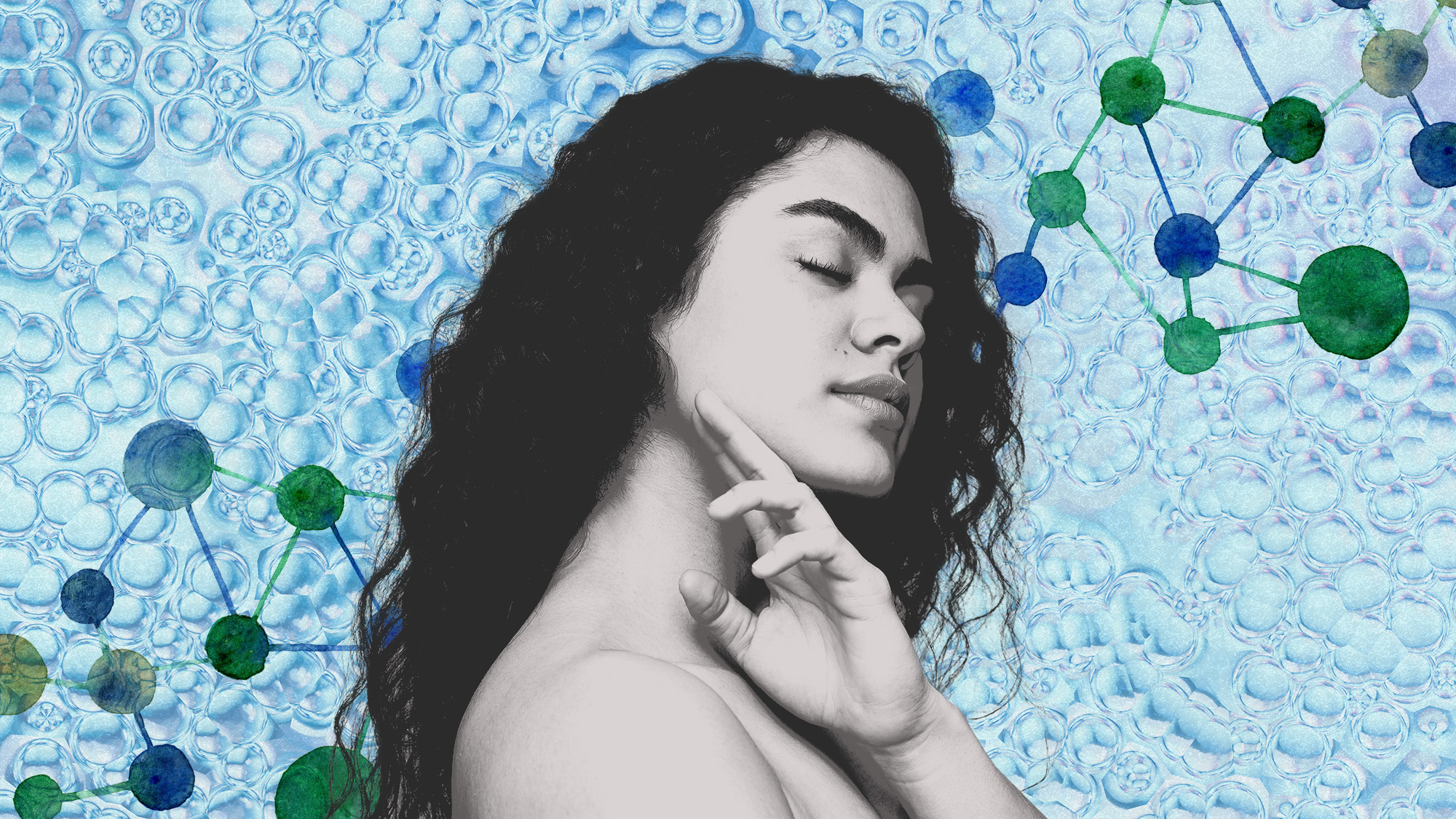Exosome Therapy Is Ushering in the Next Generation of Skin and Hair Rejuvenation
\201cThink of exosomes as the body’s own information superhighway.\201d


The aesthetics space is largely defined by injectables, lasers, and topical treatments: Botox, filler, and IPL lasers are commonly thrown around in colloquial conversation. But the other side of aesthetics covers a completely reverse approach. “It’s not all about what we do to our patients from the outside-in. We are trying to harness the power of our own cell regeneration,” says board-certified dermatologist Dr. Julie Russak. “We are starting more and more heavily relying on stimulating our cells to regenerate.” For the past few years, that’s involved plasma-rich platelet injections that use a patient’s own blood to spur hair regeneration or collagen production (think: Vampire facial). More recently, the discussion has pivoted, hard and fast, to something called Exosome Therapy.
“Exosomes seem to be the new hot thing in the search for the fountain of youth,” states Dr. Sanjay Batra, a regenerative medicine specialist and founder of WeThrivv. Even though exosomes were discovered nearly four decades ago, it’s only recently that their existence has infiltrated the aesthetics conversation in the US. Unsurprisingly, Korea was an early adopter—exosome-based skin boosters have been common practice for years. Now? You’ll find dermatologists and plastic surgeons across the globe discussing exosomes’ potential to stimulate collagen and elastin, or upend the approach to hair growth. Skincare brands are inching in on the conversation, with brands like Dr. Barbara Sturm, Elevai, and ExoCel, a K-beauty brand, releasing over-the-counter products that leverage exosomes’ regenerative powers.
The space, which also has legs in more extreme biohacking (do-it-yourself biology) and regenerative medicine circles, is not regulated by the FDA. The consensus held by top doctors: Optimistic caution. “Exosomes is a very fast-growing field,” says Dr. Russak, who recently returned from a regenerative aesthetics conference in Europe where the topic was all the rage. “The biggest challenge that we are facing right now, like with anything that is new in development in medicine and science, is that it's not regulated.”
Exosomes in aesthetics falls on a spectrum—there are easy, more affordable skincare products, in-office treatments that, in practice, have been shown to speed up post-procedure healing time, and injections that the majority of U.S. doctors will not endorse at this time. To get a deeper understanding of the increasingly popular buzzword, keep reading. Top doctors are breaking down the nuances of exosomes, ahead.
Baseline Question: What Are Exosomes?
It all starts with a stem cell, a.k.a. a human cell that can develop into a bunch of different types of cells that serve different purposes. In that stem cell is a little vesicle called an exosome. Exosome research is, per Dr. Batra, in its infancy, but the widely held belief at this point in time is that exosomes are comparable to “the body’s own information superhighway.” Exosomes carry “a very compelling payload of molecules like proteins, lipids, and mRNA,” which make them ideal information carriers that help cells communicate. They have the power to send a strong signal from one cell to another, telling receptors to produce more collagen, increase elastin, grow hair, heal faster, quicker—the list goes on.
The concept is very similar to that of PRP, or platelet rich plasma—which harnesses naturally occurring growth factors. “PRP is where we take the patients' own blood, we isolate platelets within them, and get all the signaling molecules from inside our own platelets,” explains Dr. Russak. “The caveat to it is you’ll only have good regeneration if you’re healthy, young, and have strong regenerative signals.” Exosomes, which result from a complex manufacturing process that leverages donor tissue like placenta, bone marrow, or umbilical cord, remove the variability. “The exosomes are exactly what we were trying to get in the past from our own platelets. They have a strong signal and give us much better results, which is why it’s replacing PRP in our practices.”
Do Exosomes Have Proven Aesthetic Benefits?
The exosome space is exciting and the science is encouraging, but to be completely honest, “we really don’t know” what the proven benefits of exosomes are at this point in time, says Dr. Batra.
Stay In The Know
Get exclusive access to fashion and beauty trends, hot-off-the-press celebrity news, and more.
For the Skin
Because exosomes are thought to have regenerative properties, it’s thought that they can help spur the growth of new collagen and elastin in aging cells that are slowing down. “Collagen and elastin are two proteins that are essential for maintaining the skin’s structure and elasticity. As we age, our bodies produce less of these proteins, leading to the formation of wrinkles and sagging skin,” explains board-certified dermatologist Dr. Elizabeth Houshmand. “Exosomes can potentially be quite useful because of their ability to promote angiogenesis (new blood vessel formation which helps to feed nutrients to your cells), increase collagen production, and improve tissue regenerative capacity.”
In practice, doctors have also seen exosome therapy to be promising for patients with rosacea, eczema, or a compromised skin barrier. “We’ve seen exosomes actually make the skin barrier healthier and stronger, which can improve rosacea,” says Dr. Russak.
For the Hair
When dealing with hair loss, patients have historically had few options: Supplements, PRP injections, prescription drugs, and Rogaine. But now, exosomes might be another, more sought-after, treatment option. “It is thought that exosomes may take resting hair follicles and convert them to growth phase, thereby increasing the number of visible hairs and their diameter,” says Dr. Batra.
While clinical trials and regulation would be needed before a safe rollout is seen in the US, Dr. Russak does feel like exosomes could tremendously improve hair regeneration. “This exists in other markets already. Having a safe and regulated form will augment our process.”
Am I a Candidate?
“Because exosomes rejuvenate the skin, anyone seeking healthy, plump, and radiant looking skin is a good candidate,” says Dr. Batra. “It’s a great therapy for someone looking to improve uneven skin tone, fine lines, and wrinkles.” It can be used in both males and females and be preventative or therapeutic in nature. “For anyone with skin issues or experiencing hair loss, exosome therapy may be an excellent option.”
What Does Exosome Therapy Entail?
The way in which you get your exosome booster is varied. Intravenous exosome injections do exist; however, the practice is not legal in the US, can be dangerous, and may not provide any real results. That said, topical application in a doctor’s office and over-the-counter skincare products that feature exosomes as a star ingredient are gaining popularity stateside.
Topical Application
Perhaps the most widespread use of exosomes at this point in time is a topical cosmetic applied to the skin. “Exosomes come in a vial and are in a liquid form,” Dr. Houshmand explains. “They are applied topically to the skin post laser, microneedling, chemical peel, or scalp treatments of microneedling or PRP." Plastic surgeons are also using them after completing a face lift. The point? Fast recovery and better results.
“The results themselves are being augmented—there’s improvement in the quality of the skin, fine lines and wrinkles are reduced, and pigment is better,” says Dr. Russak. An intense treatment isn’t necessary however—doctors and medi-spas are also incorporating exosomes into regular facials.
Over-the-Counter Products
More recently, skincare brands have started to get in on the exosome action. The concentration is going to be lower than an in-office treatment, however the results show promise. “Exosomes in skincare are nano-sized vesicles that are secreted by many cells in the body and can carry information from one cell to another,” explains Dr. Houshmand. “They can include peptides, amino acids, lipids, growth factors, and target healing and repair. We’re still in the early stages, but they could enhance wound healing, fight pigmentation, and increase the protection against free radicals”
Like most good things however, results take time. You may start to see the exosome’s effects take hold in a few weeks, but full benefits can take up to six months, according to Dr. Batra.
It’s Controversial, But Why?
The biggest issue with exosomes is that the practice is unregulated. The FDA ruled that exosomes qualify as a drug in 2019, and since then, not one exosome treatment has been FDA-approved. “Until we actually get good FDA regulation on the quality of exosome that’s required to be in a product, there’s going to be a lot of products that are not up to par,” says Dr. Russak. “Until we get good quality control, it’s really up to providers to do their due diligence and figure out what they’re offering to their patients.”
Lack of regulation in mind, the risks are greater—especially since exosomes can be derived from human tissues. “Exosomes are generally derived from human cells and tissues, and there is the risk of infection which potentially could be bacterial, viral, or fungal,” explains Dr. Houshmand.
To sum it all up: There’s a lot of promise in the exosome landscape, but more research and studies are needed before the practice is widely embraced.
How Much Does It Cost?
Exosome-packed skincare is going to be the easiest point of entry, but the products are still going to be in the hundreds. As for in-office treatments? It’s going to vary based on location, but you’re probably looking at anywhere from a couple hundred to a couple thousand dollars—all out of pocket. “Please remember that virtually all of the treatments being discussed are cash-pay for the patient and they are likely to be fairly expensive,” says Dr. Batra. “There is no doubt that many health care providers earn a steady stream of their revenue by way of cash and credit card swipes without necessarily promising anything.”
Meet the Experts

Julie E. Russak, M.D., FAAD., is a Board Certified Dermatologist, Fellow of the American Academy of Dermatology and founder of Russak Dermatology Clinic. Dr. Russak has received numerous honors and recognition of her clinical excellence, including being selected as a “New York Super Doctor” by The New York Times. Dr. Russak currently serves as Assistant Clinical Professor at Mount Sinai Hospital, where she teaches dermatology residents and medical students. Her clinical interests and expertise extend to many aspects of general, cosmetic and pediatric dermatology, skin cancer and dermatologic surgery. Dr. Julie Russak completed her undergraduate studies at Hunter College with a B.S. Magna Cum Laude in Biological Sciences with Phi Beta Kappa Honors. During her undergraduate tenure, she garnered a prestigious award from the Howard Hughes Medical Institute for her studies and excellence in genetics and immunology. Dr. Julie Russak attended New York University School of Medicine, graduating with Honors and the prestigious Marion B. Sulzberger Dermatology Award.
Dr. Russak completed her residency training in dermatology at the Dartmouth Hitchcock Medical Center, where she was appointed to serve as Chief Resident. She continued to expand her extensive research by completing an Oncology Melanoma Fellowship with world-renowned Melanoma expert Dr. Darrell Rigel. In March 2013 she founded her private practice, Russak Dermatology Clinic, located in midtown Manhattan to fulfill her goal of providing comprehensive medical and cosmetic skin care to her patients.

Dr. Batra obtained his PhD in medical physiology from the University of Ottawa, Canada and completed post-doctoral training in Japan and Switzerland. He is a Fellow of the American College of Cardiology and also a former Adjunct Professor at the Wake Forest Institute for Regenerative Medicine. Sanjay has 25 years of global healthcare and entrepreneurial experience in start-ups, biotech and large pharma including 10 years in the Johnson & Johnson family of companies, culminating as Vice President, R&D Pharmaceuticals, Asia-Pacific and Japan. In his career Dr. Batra has been directly involved in over 80 clinical trials in all phases of development. He started VIAS Partners in 2013 with the aspiration to take his diverse experiences and global network to partner with entrepreneurs and companies to advance their business with value, innovation and strategy.
Dr. Elizabeth Bahar Houshmand is a double board certified dermatologist specializing in cutaneous laser surgery and the dermatologic care of patients with a special interest in Cosmetic Dermatology, Laser Medicine , Acne, Hair Loss, and Melasma. Dr. Houshmand’s completed her undergraduate degree as a Presidential Honors scholar from New York University and graduated medical school with prestigious clinical distinction honors. She completed an Internal Medicine Residency at Georgetown University Hospital and is Board Certified in both Internal Medicine and Dermatology. She completed her Dermatology Residency at Wright State University and served as chief resident. Dr. Houshmand received several prestigious scholarships through the WDS and ASDS has trained with pioneers in the field of cosmetic skin treatments and dermatologic surgery. She was selected by the AAD as one of three dermatology resident recipients of the prestigious AAD International Grant. She is an international speaker, trainer, author, and medical news correspondent and an internationally recognized leader in cosmetic dermatology. This varied educational background and training brings Dr. Houshmand’s wealth of knowledge on the newest and latest treatments in medical, surgical, and cosmetic dermatology to her patients. Dr. Houshmand is fluent in English, Spanish and Farsii and enjoys utilizing her skills in providing optimal care for her patients of many diverse backgrounds, believing that being able to connect with them on a personal level allows her to create a strong, trusting relationship with her patients and provide them with optimal care.

Samantha Holender is the Senior Beauty Editor at Marie Claire, where she reports on the best new launches, dives into the science behind skincare, and shares the breakdown on the latest and greatest trends in the beauty space. She's studied up on every ingredient you'll find on INCI list and is constantly in search of the world's glowiest makeup products. She's constantly tracking the biggest nail and hair trends to pop up in the beauty space, going backstage during fashion weeks, tracking celebrity looks, and constantly talking to celebrity hair stylists, nail artists, and makeup artists. Prior to joining the team, she worked as Us Weekly’s Beauty and Style Editor, where she stayed on the pulse of pop culture and broke down celebrity beauty routines, hair transformations, and red carpet looks. Her words have also appeared on Popsugar, Makeup.com, Skincare.com, Delish.com, and Philadelphia Wedding. Samantha also serves as a board member for the American Society of Magazine Editors (ASME). She first joined the organization in 2018, when she worked as an editorial intern at Food Network Magazine and Pioneer Woman Magazine. Samantha has a degree in Journalism and Mass Communications from The George Washington University’s School of Media and Public Affairs. While at GWU, she was a founding member of the school’s HerCampus chapter and served as its President for four years. When she’s not deep in the beauty closet or swatching eyeshadows, you can find her obsessing over Real Housewives and all things Bravo. Keep up with her on Instagram @samholender.
-
 I’m Shopping H&M’s New Arrivals to Fill Every Gap in My Summer Wardrobe
I’m Shopping H&M’s New Arrivals to Fill Every Gap in My Summer WardrobeRunning to score these under-$100 finds before they sell out.
By Brooke Knappenberger
-
 Sienna Miller Just Doubled Up on an Editor-Favorite Trench Coat
Sienna Miller Just Doubled Up on an Editor-Favorite Trench CoatThis Sézane jacket is a true masterpiece.
By Halie LeSavage
-
 Will Prince Louis be Granted a Title from Dad Prince William That's "Tainted With Sadness?"
Will Prince Louis be Granted a Title from Dad Prince William That's "Tainted With Sadness?"Royal historian Jessica Storoschuk tells 'Marie Claire' what Prince Louis and Prince George's future titles could look like.
By Kristin Contino